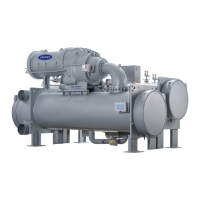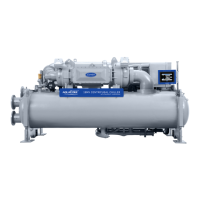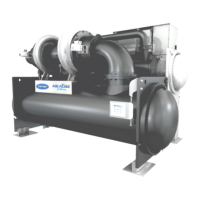49
CHECK SENSOR ACCURACY — Place the sensor in a
medium of known temperature and compare that temperature
to the measured reading. The thermometer used to determine
the temperature of the medium should be of laboratory quality
with 0.5F (0.25C) graduations. The sensor in question should
be accurate to within 2F (1.2C).
Note that the PIC5 control module, MAINTENANCE
menu, offers a temperature sensor calibration feature where the
sensor temperature can be offset. Note that only the four water
temperatures can be calibrated. To use this feature, place the
sensor at 32°F (0C) or other known temperature. Read the raw
temperature and calculate offset based on the reading seen in
the TEMP_CAL menu. Enter and execute the offset, which
cannot exceed ± 2F (1.2C).
See Fig. 2 for sensor locations. The sensors are immersed
directly in the refrigerant or water circuits. When installing a
new sensor, apply a pipe sealant or thread sealant to the sensor
threads.
An additional thermistor, factory installed in the bottom of
the cooler barrel, is displayed as Evap Refrig Liquid Temp on
the TEMPERATURES display screen. This thermistor pro-
vides additional protection against a loss of water flow.
DUAL TEMPERATURE SENSORS — For servicing con-
venience, there are 2 redundant sensors each on the bearing and
motor temperature sensors. If one of the sensors is damaged,
the other can be used by simply moving a wire. The number 2
terminal in the sensor terminal box is the common line. To use
the second sensor, move the wire from the number 1 position to
the number 3 position. See Fig. 43 or Fig. 44.
Checking Pressure Transducers — There are 6
factory-installed pressure transducers measuring refrigerant
pressure: condenser pressure, evaporator pressure, refrigerant
pump suction, discharge pressure, bearing inlet pressure, and
bearing outlet pressure.
These transducers can be calibrated if necessary. It is
necessary to calibrate at initial start-up, particularly at high
altitude locations, to ensure the proper refrigerant temperature/
pressure relationship. Each transducer is supplied with 5 vdc
power. If the power supply fails, a transducer voltage reference
alarm occurs. If the transducer reading is suspected of being
faulty, check the TRANSDUCER VOLTAGE REF supply
voltage. It should be 5 vdc ± 0.5 v as displayed in MAINTE-
NANCE MENU MAINTENANCE OTHERS, where all
the transducer voltages are shown. If the TRANSDUCER
VOLTAGE REF supply voltage is correct, the transducer
should be recalibrated or replaced.
Also check that any external inputs have not been grounded
and are not receiving anything other than a 4 to 20 mA signal.
TRANSDUCER REPLACEMENT — Since the transduc-
ers are mounted on Schrader-type fittings, there is no need
to remove refrigerant from the vessel when replacing the
transducers. Disconnect the transducer wiring. Do not pull
on the transducer wires. Unscrew the transducer from the
Schrader fitting. When installing a new transducer, do not
use pipe sealer (which can plug the sensor). Put the plug
connector back on the sensor and snap into place. Check for
refrigerant leaks.
COOLER, CONDENSER, REFRIGERANT PUMP SUC-
TION AND DISCHARGE, BEARING INLET AND OUT-
LET PRESSURE TRANSDUCER CALIBRATION — Cal-
ibration can be checked by comparing the pressure readings
from the transducer to an accurate refrigeration gage reading.
These readings can be viewed or calibrated from the HMI
screen. The transducer can be checked and calibrated at 2
pressure points. These calibration points are 0 psig (0 kPa)
and between 10 and 30 psig (69 and 207 kPa). Connect pres-
sure transducer to Schrader connection. To calibrate these
transducers:
1. Shut down the compressor, cooler, and condenser pumps.
NOTE: There should be no flow through the heat
exchangers.
2. Disconnect the transducer in question from its Schrader
fitting for cooler or condenser transducer calibration. For
other pressure or flow device calibration, leave the trans-
ducer in place.
NOTE: If the cooler or condenser vessels are at
0 psig (0 kPa) or are open to atmospheric pressure, the
transducers can be calibrated for zero without remov-
ing the transducer from the vessel.
Fig. 43 — Motor Housing Temperature Sensors
Fig. 44 — First and Second Stage Bearing
Temperature Wiring and Motor Thermistor Wiring
WARNING
Be sure to use a back-up wrench on the Schrader fitting
whenever removing a transducer, since the Schrader fitting
may back out with the transducer, causing a large leak and
possible injury to personnel.
1ST STAGE
BEARING
TEMP SENSOR
2ND STAGE
BEARING
TEMP SENSOR
MOTOR TEMP
SENSOR
ELEMENT
ELEMENT
ELEMENT
BLK
WHT RED
ELEMENT

